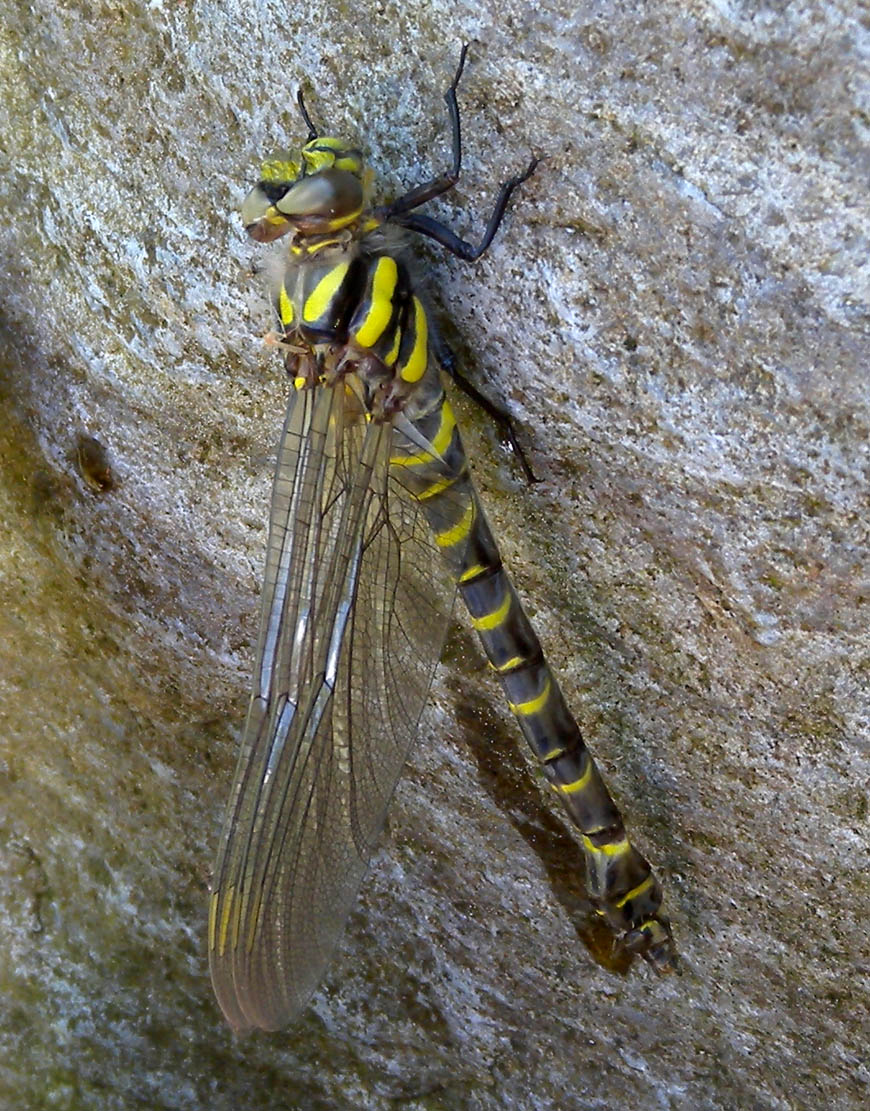Zweigestreifte Quelljungfer
© Giancarlo Secco & Carlo Bonardi (Foto) & Clemens M. Brandstetter (Text)
 (from Boudot & al. 2009:144): A single voucher record of Cordulegaster b. boltonii from Corsica refers to a dead male found on the road in 1995 at Cirendino (Zonza). An additional sight record refers to a male Cordulegaster patrolling over a brook in the Asco valley on 22.VII.2007, ascribed here to the same taxon due to its previously known occurence, the lack of records of other Cordulegaster species and the low probability that C. trinacriae and C. bidentata can reach Corsica. Some individuals of C. b. boltonii from the southwestern France, northwestern Spain and nothern Portugal are atypical – lacking the black bar on the front, with additional yellow dots at the end of the abdomen – but remain close to the nominal subspecies. Those of Liguria and the Apennine show a black occipital triangle generally with two yellow spots but are to be referred to the nominal subspecies as well. In addition to the C. b.boltonii, three southern subspecies have been described, namely C. b. immaculifrons Selys, 1850 (southeastern France and northwestern Italy), C. b. iberica Boudot & Jaquemin, 1994 (southern Iberia), C. b. algirica Morton, 1916 (southernmost Spain, Marocco, formerly Algeria). All subspecies are connected by heterogeneous hybrid populations. Genetic studies are in progress to better understand the phylogeny of this complex. The southernmost subspecies, C. b. algirica, is presently confined to southern Spain and Marocco, as no records have been available from Algeria for almost a century. Climate change and habitat degradation are likely to cause this subspecies to decline in the future.
(from Boudot & al. 2009:144): A single voucher record of Cordulegaster b. boltonii from Corsica refers to a dead male found on the road in 1995 at Cirendino (Zonza). An additional sight record refers to a male Cordulegaster patrolling over a brook in the Asco valley on 22.VII.2007, ascribed here to the same taxon due to its previously known occurence, the lack of records of other Cordulegaster species and the low probability that C. trinacriae and C. bidentata can reach Corsica. Some individuals of C. b. boltonii from the southwestern France, northwestern Spain and nothern Portugal are atypical – lacking the black bar on the front, with additional yellow dots at the end of the abdomen – but remain close to the nominal subspecies. Those of Liguria and the Apennine show a black occipital triangle generally with two yellow spots but are to be referred to the nominal subspecies as well. In addition to the C. b.boltonii, three southern subspecies have been described, namely C. b. immaculifrons Selys, 1850 (southeastern France and northwestern Italy), C. b. iberica Boudot & Jaquemin, 1994 (southern Iberia), C. b. algirica Morton, 1916 (southernmost Spain, Marocco, formerly Algeria). All subspecies are connected by heterogeneous hybrid populations. Genetic studies are in progress to better understand the phylogeny of this complex. The southernmost subspecies, C. b. algirica, is presently confined to southern Spain and Marocco, as no records have been available from Algeria for almost a century. Climate change and habitat degradation are likely to cause this subspecies to decline in the future.
 Società italiana per lo studio e la conservazione delle libellule.
Società italiana per lo studio e la conservazione delle libellule.
Die Zweigestreifte Quelljungfer, Cordulegaster boltonii (Donavan 1807), kommt vom nordwestlichen Afrika über Spanien, Frankreich, Corsica, Nord- und Mittelitalien bis ins südliche Österreich vor. Im südlichen Italien und auf Sizilien wird sie durch die Italienische Quelljungfer ersetzt. Im Osten erreicht die Art das östliche Russland und im Norden Mittelskandinavien. Sie leben an vegetationsfreien Gebirgsbächen und in Fortsetzung an den Fliessgewässern der anschliessenden Täler. Flussbegradigungen und – Verbauungen, Verrohrung gefährden die Art.
Froufe & al. (2014) präsentieren eine Studie über genetische Untersuchungen an der Gattung Cordulegaster. Die bisher traditionell unterschiedenen Artengruppen haben sich auch genetisch bestätigt: "Although Odonata are a key component of many freshwater ecosystems, their taxonomy and evolutionary history is still far from being well resolved. In the present study, we report the first molecular phylogeny for the Western Palaearctic Cordulegaster genus (Odonata: Anisoptera: Cordulegastridae). We sequenced fragments of both mitochondrial and nuclear genes [cytochrome c oxidase I (COI) and Internal Transcribed Spacer-1 (ITS-1)] from eight species and 13 subspecies, from western, southern and central Europe, Turkey, and Morocco. Our data support the existence of two major groups corresponding to the traditional boltonii– and bidentata-groups. Both groups are monophyletic based on COI sequences and the distinctiveness of Cordulegaster princeps, Cordulegaster trinacriae, Cordulegaster picta and Cordulegaster heros relative to Cordulegaster boltonii, and Cordulegaster helladica and Cordulegaster insignis relative to Cordulegaster bidentata, is confirmed. All species are also monophyletic for ITS-1, with the exception of Cordulegaster helladica buchholzi, which shares the haplotype with C. insignis. Although moderate levels of genetic diversity were found within C. boltonii, there was no clear separation among the four subspecies, with the exception of the populations of Cordulegaster boltonii algirica from North Africa. Similarly, no genetic differentiation was found between the two subspecies of C. bidentata, Cordulegaster bidentata bidentata and Cordulegaster bidenta sicilica.."

Männchen der Zweigestreiften Quelljungfer – Sant'Albano Stura, Prov. Cuneo,

Weibchen aus dem Val Anzasca, 680 m, Prov. Verbano-Cusio-Ossola (VB).
Literatur:
Boudot J.-P., V. J. Kalkman, M. Amorín, T. Bogdanović, A. Rivera,G. Degabriele, J.L. Dommanget, S. Ferreira, B. Garrigós, M. Jović, M. Kotarac, W. Lopau, M. Marinov, N. Mihoković, E. Riservato, B. Samraoui & W. Schneider 2009: Atlas of the Odonata of the Mediterranean and North Africa. – Libellula Supplement 9:1-256.
Donovan E. 1807: The natural history of British Insects explaining them in their several states, with the periods of their transformations, their food, economy etc. together with the history of such minute Insects as require investigation by the microscope. – London, Rivington 16 volumes.
Froufe E., Ferreira S., Boudot J.-P., Alves P.C. & D. J. Harris 2014: Molecular phylogeny of the Western Palaearctic Cordulegaster taxa (Odonata: Anisoptera: Cordulegastridae). – Biolog. Journ. Linn. Soc. 111: 49,57.
